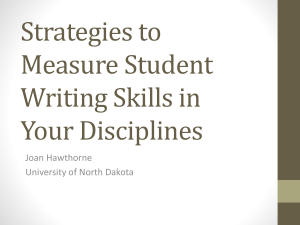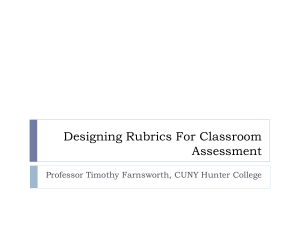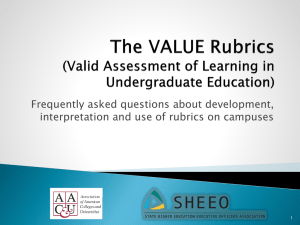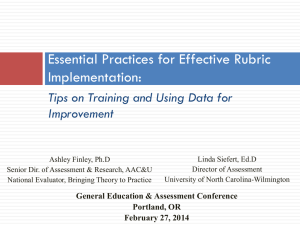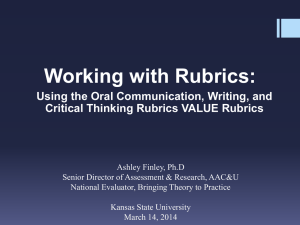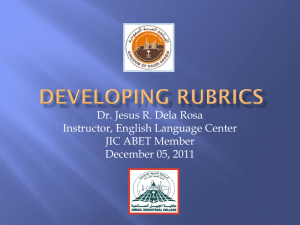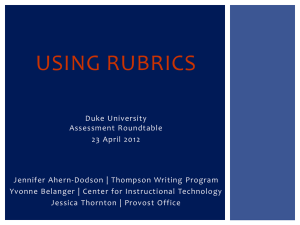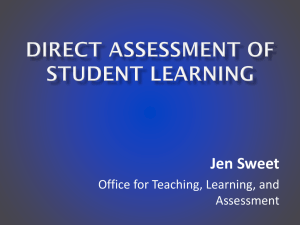Rubrics presentation by Sharon Kerrick
advertisement
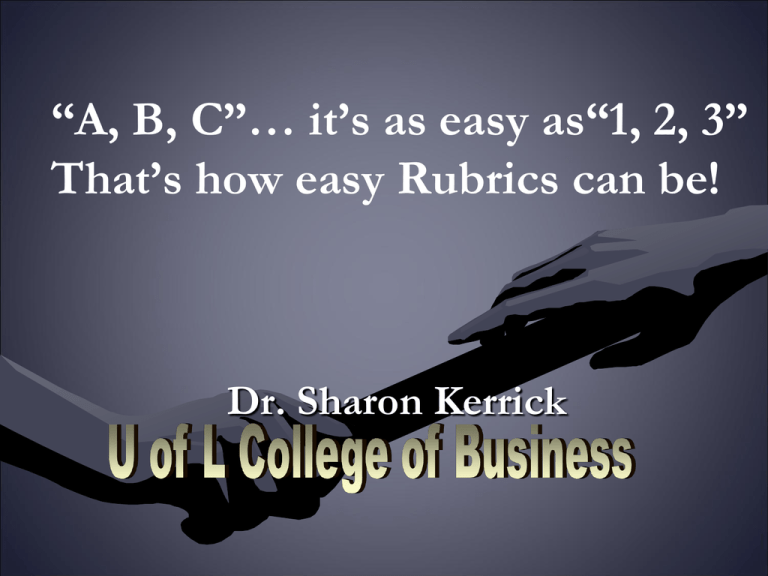
“A, B, C”… it’s as easy as“1, 2, 3” That’s how easy Rubrics can be! Dr. Sharon Kerrick Exactly what is a rubric? • In general a rubric is a scoring guide used in subjective assessments. • A rubric implies rules defining the criteria of an assessment system followed in evaluation. • A rubric can be an explicit description of performance characteristics corresponding to a point on a rating scale. • A scoring rubric makes explicit expected qualities of performance on a rating scale or the definition of a single scoring point on a scale. Who uses Rubrics? • Audience– how & why do you use them? (This is not a Trick question ---we just want to hear how folks are using them currently) What do they look like???? Project Rubric (handout) Student Presentations Rubric Why use “it” ?… • “Research shows that rubrics save professors’ time –while conveying meaningful and timely feedback for students; –AND promoting self-regulated and independent learning.” Why now…? • “Increasingly, rubrics are being used in college classrooms to improve the effectiveness and the efficiency of grading. • By making our grading criteria more transparent, a well-thought-out rubric can both enhance student learning and save professors time” (Berkeley.edu) What else… • A rubric is a scoring guide that seeks to evaluate a student's performance based on the sum of a full range of criteria rather than a single numerical score. • A rubric is a working guide for students and teachers, usually handed out before the assignment begins in order to get students to think about the criteria on which their work will be judged. • Rubrics can be created for any content area including math, science, history, business, writing, foreign languages, drama, art, music, etc… • Rubrics can be potentially be used to grade any assignment or task: research papers, book reviews, participation in discussions, laboratory work, portfolios, oral presentations, group work, etc… Pro’s & Con’s • Use the Flip Chart paper at your table and record a list of “Pro’s” and “Con’s” regarding using Rubrics There are many ADVANTAGES using rubrics: Professors can increase the quality of their direct instruction by providing focus, emphasis, and attention to particular details as a model for students. Students have explicit guidelines regarding professors expectations. What's the difference between analytic and holistic rubrics? • Analytic rubrics identify and assess components of a finished product. • Holistic rubrics assess student work as a whole. Now, let’s talk about the variety of ways rubrics may be set up • • • • • Categories of accumulated points Notecard category style Levels designated for mastery Development stages Scoring rubric This list is not all encompassing or inclusive Categories of accumulated points Use for Peer Assessments Essay Research Rubric Essay/ Papers Reviewed Physics Lab Rubric Think about level of scoring ---Even numbered items allows falling in the “middle” –old forces decision of assessment Group Projects Consolidated project peer evaluations may be worth X% contributing to Y% of overall team project grade --- Recommended that peer evaluations used/turned in throughout project not just at the end Scoring Rubric • Experts believe that rubrics improve students' end products and therefore increase learning. • When teachers evaluate papers or projects, they know implicitly what makes a good final product and why. • When students receive rubrics beforehand, they understand how they will be evaluated and can prepare accordingly. • Developing a grid and making it available as a tool for students' use will provide the scaffolding necessary to improve the quality of their work and increase their knowledge. Getting started… 1. Think through your learning objectives. 2. Decide what kind of scale you will use. 1. Analytic/Holistic 2. 4-point scale, 6-point scale– even # scales forces a decision point, or use letter grades, words such as “meets”/”exceeds”/”does not meet” 3. Describe the characteristics of student work at each point on your scale. 4. Test your rubric on student work. Bloom’s taxonomy • Level Type of Activity or Question Verbs Used for Objectives: Lowest level: Knowledge: fine, memorize, repeat, match, record, list, recall, name, relate, collect, label, specify, cite, enumerate, recite, tell, recount Comprehension: restate, summarize, differentiate, discuss, describe, recognize, explain, express, identify, locate, report, retell, review, translate, paraphrase Application: exhibit, solve, manipulate, interview, simulate, apply, employ, use, demonstrate, dramatize, practice, illustrate, operate, calculate, show, experiment Bloom’s taxonomy • Higher levels Analysis: interpret, classify, analyze, arrange, differentiate, group, compare, organize, contrast, examine, scrutinize, survey, categorize, dissect, probe, create an inventory, investigate, question, discover, inquire, distinguish, detect, diagram, chart, inspect Synthesis: compose, set up, plan, prepare, propose, imagine, produce, hypothesize, invent, incorporate, develop, generalize, design, originate, formulate, predict, arrange, assemble, construct, create Evaluation: judge, assess, decide, measure, appraise, estimate, evaluate, rate, deduce, compare, score, value, predict, revise, choose, conclude, recommend, determine, criticize, test Learning Objectives 1. 2. 3 4. What type of Rubric will you use? www.teachervision.fen.com University of Louisville- QEP – rubrics https://docushare.louisville.edu/dsweb/Get/ Document-12804/ECrubric06s.pdf BUT WAIT….You guys have something even better…. • Sharepoint link with examples are ALREADY loaded and ready for you to use!!! WOW!! Thank you for your attention! GO TRY IT! Resources/references • http://www.rcampus.com • http://gsi.berkeley.edu/resources/grading/rubricsTips. html • http://rubistar.4teachers.org • http://www.cotf.edu/ete/teacher/rubricassess.html • http://www.uwstout.edu/soe/profdev/rubrics.shtml • https://docushare.louisville.edu/dsweb/Get/Documen t-12804/ECrubric06s.pdf • Northwest Regional Educational Laboratory (NWREL)

